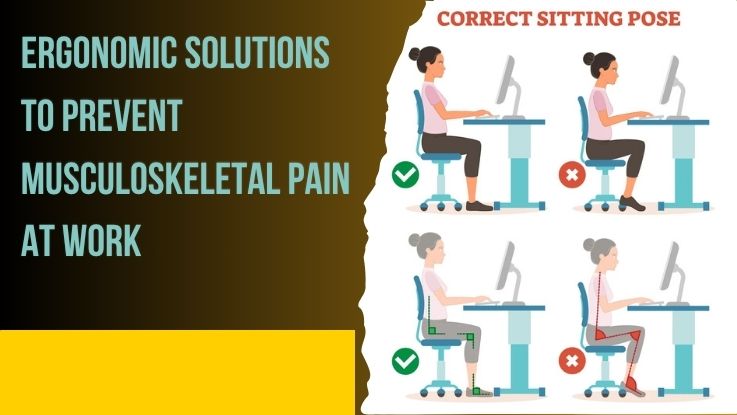
Musculoskeletal pain, affecting muscles, bones, joints, and connective tissues, can disrupt daily life, whether from injury, poor posture, or chronic conditions. In 2025, advancements in medical science and holistic approaches offer innovative ways to manage this discomfort of musculoskeletal pain, blending cutting-edge treatments with time-tested natural methods to help you reclaim mobility and comfort. From wearable tech to mindful practices, these solutions are designed to address pain effectively and sustainably.
Wearable technology, like TENS (Transcutaneous Electrical Nerve Stimulation) units and infrared therapy patches, has revolutionized pain management. These portable devices deliver targeted electrical impulses or heat to soothe sore muscles and joints. In 2025, compact, app-controlled wearables allow users to customize intensity and track progress, making them a non-invasive, drug-free option for musculoskeletal pain relief.
Stem cell therapy and platelet-rich plasma (PRP) injections are gaining traction as regenerative treatments for musculoskeletal pain. By harnessing the body’s natural repair mechanisms, these therapies promote tissue healing in joints and muscles. In 2025, advancements have made these treatments more accessible, offering long-term relief for chronic pain caused by arthritis or injuries.
Physical therapy remains a cornerstone of musculoskeletal pain management. In 2025, therapists use AI-driven motion analysis tools to create personalized exercise plans that strengthen weak muscles and improve joint mobility. Regular sessions, combined with at-home exercises, can significantly reduce pain and prevent recurrence, especially for back and neck issues.
Yoga and Tai Chi, ancient practices emphasizing gentle stretching and balance, are highly effective for musculoskeletal pain. In 2025, virtual classes and AI-guided sessions make these practices accessible to all. Poses like Cat-Cow or Tai Chi’s Wave Hands Like Clouds improve flexibility, reduce stiffness, and promote relaxation, easing pain naturally.
Diet plays a crucial role in managing musculoskeletal pain. In 2025, personalized nutrition plans based on genetic profiling highlight anti-inflammatory foods like turmeric, fatty fish, and leafy greens. Avoiding processed foods and incorporating supplements like omega-3s or collagen can reduce inflammation and support joint health, offering a holistic remedy.
Alternating between cryotherapy (cold therapy) and heat therapy remains a powerful remedy. Cold packs reduce swelling in acute injuries, while heat pads relax tight muscles. In 2025, portable cryotherapy chambers and smart heating wraps with precise temperature controls enhance convenience, providing fast relief for musculoskeletal discomfort.
Acupuncture, rooted in traditional Chinese medicine, involves inserting fine needles into specific points to balance energy and relieve pain. In 2025, research continues to validate its efficacy for musculoskeletal conditions like fibromyalgia and lower back pain. Certified practitioners and at-home acupressure tools make this remedy widely available.
Poor posture from prolonged sitting or improper workspaces often triggers musculoskeletal pain. In 2025, ergonomic furniture like adjustable standing desks and supportive chairs, paired with posture-tracking wearables, helps prevent strain. Simple changes, like aligning your monitor or using lumbar cushions, can significantly reduce discomfort.
Massage therapy soothes tense muscles and improves circulation, alleviating musculoskeletal pain. In 2025, robotic massage chairs and AI-powered handheld devices mimic professional techniques, offering affordable at-home relief. Regular sessions, whether with a therapist or device, target trigger points and promote recovery.
Chronic musculoskeletal pain often has a psychological component. Cognitive Behavioral Therapy (CBT) and mindfulness meditation help reframe pain perception and reduce stress, which can amplify discomfort. In 2025, apps with guided CBT exercises and virtual reality mindfulness sessions make these remedies accessible, empowering users to manage pain mentally and physically.
Q1: What causes musculoskeletal pain?
A: Musculoskeletal pain can stem from injuries, overuse, poor posture, arthritis, or chronic conditions like fibromyalgia. Stress and sedentary lifestyles also contribute.
Q2: Are there risks with wearable pain relief devices?
A: When used as directed, devices like TENS units are safe. However, consult a doctor if you have a pacemaker, epilepsy, or are pregnant.
Q3: How often should I do yoga for pain relief?
A: Practicing yoga 2–3 times per week for 20–30 minutes can yield benefits. Start with gentle poses and consult an instructor for tailored guidance.
Q4: Can diet alone eliminate musculoskeletal pain?
A: While a balanced, anti-inflammatory diet supports pain management, it’s most effective when combined with other remedies like exercise or therapy.
Q5: Is regenerative medicine suitable for everyone?
A: Stem cell or PRP therapy may not be ideal for all patients. A healthcare provider can assess eligibility based on your condition and medical history.
| Categories: | Items for Sale / Health & Beauty Items |
| Phone: | 48452197890 |
| Address: | 838 Broadway, New York, NY 10003, USA |
| Email: | shopiawilliams63@outlook.com |